STIHL FS 360 C-E Owner's Manual
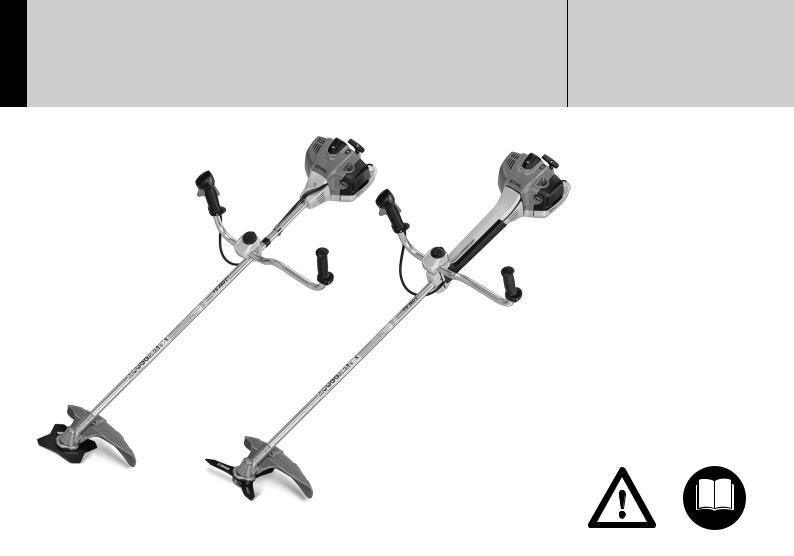
{
STIHL FS 260 C, 360 C
Instruction Manual Manual de instrucciones
Warning!
Read and follow all safety precautions in Instruction Manual – improper use can cause serious or fatal injury.
Advertencia!
Lea y siga todas las precauciones de seguridad dadas en el manual de instrucciones – el uso incorrecto puede causar lesiones graves o mortales.
Instruction Manual 1 - 53
Manual de instrucciones 55 - 114

Contents
|
|
Guide to Using this Manual |
2 |
|
|
Safety Precautions and Working |
|
|
|
Techniques |
3 |
Manual |
|
Approved Combinations of Cutting |
|
|
Attachment, Deflector, Limit Stop |
16 |
|
Instruction |
|
and Harness |
|
|
Mounting the Bike Handle |
17 |
|
|
|
||
Original |
|
Mounting the Deflector |
20 |
|
Mounting the Cutting Attachment |
21 |
|
|
|
||
|
|
Fuel |
24 |
|
be recycled. |
Fueling |
25 |
|
Fitting the Full Harness |
26 |
|
|
Balancing the Trimmer/Brushcutter |
27 |
|
|
can |
Starting / Stopping the Engine |
28 |
|
oils, paper |
Operating Instructions |
30 |
|
Cleaning the Air Filter |
31 |
|
chlorineon-free paper |
containinksvegetable |
Engine Management |
31 |
Engine Running Behavior |
35 |
||
|
|
Adjusting the Carburetor |
32 |
|
|
Winter Operation |
32 |
|
Printing |
Spark Plug |
33 |
Printed |
Replacing the Starter Rope and |
|
|
|
|
|
|
|
|
Rewind Spring |
35 |
|
|
Storing the Machine |
37 |
|
|
Sharpening Metal Cutting Blades |
38 |
STIHLANDREAS©AG & Co. KG, 2010 |
M0A.-8621-743-0458-21.J10.DDS. GB0020000003973 |
Inspection and Maintenance by |
38 |
{ |
|||
|
|
User |
|
|
|
Inspections and Maintenance by |
|
|
|
Dealer |
39 |
|
|
Maintenance and Care |
40 |
|
|
Main Parts |
42 |
|
|
Specifications |
44 |
Special Accessories
Maintenance and Repairs
Allocation of STIHL Incorporated
Warranty Declarations
STIHL Incorporated Federal
Emission Control Warranty
Statement
Allocation of STIHL Incorporated
Warranty Declarations
STIHL Incorporated Federal
Emission Control Warranty
Statement
STIHL Incorporated California
Exhaust and Evaporative
Emissions Control Warranty
Statement
Trademarks
English
45 |
Allow only persons who fully understand |
|
this manual to operate your trimmer / |
45 |
brushcutter. |
|
46To receive maximum performance and satisfaction from your STIHL trimmer /
brushcutter, it is important that you read,
46understand and follow the safety precautions and the operating and
maintenance instructions in chapter 48 "Safety Precautions and Working
Techniques" before using your trimmer / brushcutter. For further information you
48can go to www.stihlusa.com.
Contact your STIHL dealer or the STIHL
|
distributor for your area if you do not |
|
50 |
understand any of the instructions in this |
|
manual. |
||
52 |
||
|
||
|
Warning! |
Because a trimmer / brushcutter is a high-speed cutting tool some special safety precautions must be observed to reduce the risk of personal injury. Careless or improper use may cause serious or even fatal injury.
Make sure your unit is equipped with the proper deflector, handle and harness for the type of cutting attachment being used. Always wear proper eye protection.
FS 260 C, FS 360 C |
1 |
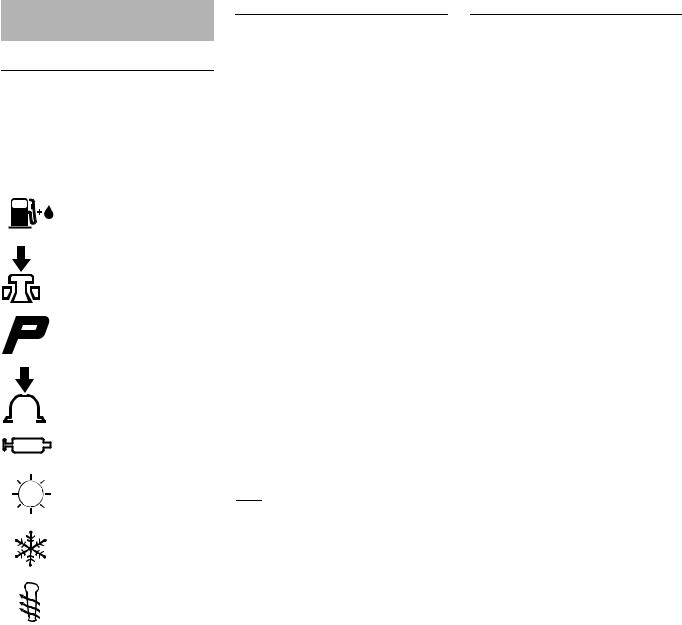
English
Guide to Using this Manual
Pictograms
The meanings of the pictograms attached to or embossed on the machine are explained in this manual.
Depending on the model concerned, the following pictograms may be on your machine.
Fuel tank for gasoline and engine oil mixture
Press to operate decompression valve
Manual fuel pump
Press to operate manual fuel pump
Filler hole for gear lubricant
Air intake summer mode
Air intake winter mode
Handle heating
Symbols in Text
Many operating and safety instructions are supported by illustrations.
The individual steps or procedures described in the manual may be marked in different ways:
N A bullet marks a step or procedure.
A description of a step or procedure that refers directly to an illustration may contain item numbers that appear in the illustration. Example:
N Loosen the screw (1). N Lever (2) ...
In addition to the operating instructions, this manual may contain paragraphs that require your special attention. Such paragraphs are marked with the symbols and signal words described below:
 Danger!
Danger!
Indicates an imminent risk of severe or fatal injury.
 Warning!
Warning!
Indicates a hazardous situation which, if not avoided, could result in severe or fatal injury.
 Caution!
Caution!
Indicates a risk of property damage, including damage to the machine or its individual components.
Engineering Improvements
STIHL’s philosophy is to continually improve all of its products. As a result, engineering changes and improvements are made from time to time. Therefore, some changes, modifications and improvements may not be covered in this manual. If the operating characteristics or the appearance of your machine differs from those described in this manual, please contact your STIHL dealer for assistance.
2 |
FS 260 C, FS 360 C |
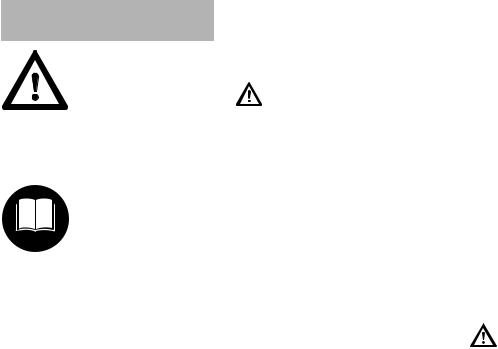
Safety Precautions and
Working Techniques
Because a clearing saw is a high-speed, fast-cut- ting power tool sometimes equipped with sharp cutting blades, special safety precautions must be observed to reduce the risk of personal injury.
It is important that you read, fully understand and observe the following safety precautions and warnings. Read the instruction manual and the safety precautions periodically. Careless or improper use may cause serious or fatal injury.
The terminology utilized in this manual when referring to the power tool reflects the fact that different types of cutting attachments may be mounted on it. The term "trimmer" is used to designate an FS unit that is equipped with a nylon line head or a head with flexible plastic blades (i.e., the PolyCut head). A "brushcutter" designates a unit equipped with a rigid metal blade. Many FS models may be used as either a trimmer or a brushcutter – therefore, the power tool is referred in this manual as a "trimmer / brushcutter." Some smaller and / or lightweight FS models may only be used as a trimmer, i.e., they may not be used with metal blades.
The term "clearing saw" indicates a high-powered trimmer / brushcutter that is particularly suited for use with a circular saw blade to clear saplings or small trees.
Warning!
As more fully explained later in these Safety Precautions, to reduce the risk of personal injury, make sure your unit is equipped with the proper deflector, limit stop and harness for the type of cutting attachment you are using. Use only cutting attachments that are specifically authorized by STIHL for use on your FS model.
Have your STIHL dealer show you how to operate your power tool. Observe all applicable local safety regulations, standards and ordinances.
 Warning!
Warning!
Do not lend or rent your power tool without the instruction manual. Be sure that anyone using it understands the information contained in this manual.
English
 Warning!
Warning!
The use of this machine may be hazardous. If the rotating line or blade comes in contact with your body, it will cut you.
When it comes in contact with solid foreign objects such as rocks or bits of metal, it may fling them directly or by ricochet in the direction of bystanders or the operator. Striking such objects could damage the cutting attachment and may cause blades to crack, chip or break. Thrown objects, including broken heads or blades, may result in serious or fatal injury to the operator or bystanders. STIHL does not recommend the use of rigid blades when cutting in stony areas.
Use your clearing saw equipped with the appropriate cutting attachment only for cutting grass, brush, wood and similar material.
Warning!
Do not use it for other purposes, since misuse may result in personal injury or property damage, including damage to the machine.
 Warning!
Warning!
Minors should never be allowed to use this power tool. Bystanders, especially children, and animals should not be allowed in the area where it is in use.
FS 260 C, FS 360 C |
3 |

English
 Warning!
Warning!
To reduce the risk of injury to bystanders and damage to property, never let your power tool run unattended. When it is not in use (e.g. during a work break), shut it off and make sure that unauthorized persons do not use it.
Most of these safety precautions and warnings apply to the use of all STIHL clearing saws. Different models may have different parts and controls. See the appropriate section of your instruction manual for a description of the controls and the function of the parts of your model.
Safe use of a clearing saw involves
1.the operator
2.the power tool
3.the use of the power tool.
THE OPERATOR
Physical Condition
You must be in good physical condition and mental health and not under the influence of any substance (drugs, alcohol, etc.) which might impair vision, dexterity or judgment. Do not operate this machine when you are fatigued.
 Warning!
Warning!
Be alert – if you get tired, take a break. Tiredness may result in loss of control. Working with any power tool can be strenuous. If you have any condition that might be aggravated by strenuous work, check with your doctor before operating this machine.
Warning!
Prolonged use of a power tool (or other machines) exposing the operator to vibrations may produce whitefinger disease (Raynaud's phenomenon) or carpal tunnel syndrome.
These conditions reduce the hand's ability to feel and regulate temperature, produce numbness and burning sensations and may cause nerve and circulation damage and tissue necrosis.
All factors which contribute to whitefinger disease are not known, but cold weather, smoking and diseases or physical conditions that affect blood vessels and blood transport, as well as high vibration levels and long periods of exposure to vibration are mentioned as factors in the development of whitefinger disease. In order to reduce the risk of whitefinger disease and carpal tunnel syndrome, please note the following:
–Most STIHL power tools are available with an anti-vibration ("AV") system designed to reduce the transmission of vibrations created by the machine to the operator's hands. An AV system is recommended for those persons using power tools on a regular or sustained basis.
–Wear gloves and keep your hands warm.
–Keep the AV system well maintained. A power tool with loose components or with damaged or worn AV elements will tend to have higher vibration levels.
–Maintain a firm grip at all times, but do not squeeze the handles with constant, excessive pressure. Take frequent breaks.
All the above-mentioned precautions do not guarantee that you will not sustain whitefinger disease or carpal tunnel syndrome. Therefore, continual and regular users should closely monitor the condition of their hands and fingers. If any of the above symptoms appear, seek medical advice immediately.
 Warning!
Warning!
The ignition system of the STIHL unit produces an electromagnetic field of a very low intensity. This field may interfere with some pacemakers. To reduce the risk of serious or fatal injury, persons with a pacemaker should consult their physician and the pacemaker manufacturer before operating this tool.
4 |
FS 260 C, FS 360 C |
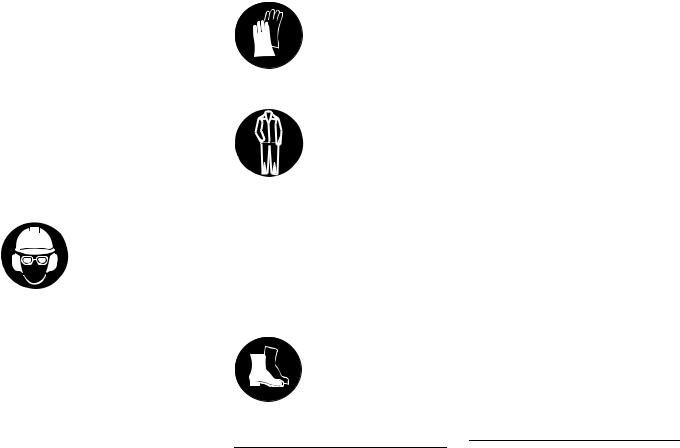
Proper Clothing
To reduce the risk of injury, the operator should wear proper protective apparel.
 Warning!
Warning!
The deflector provided with your power tool will not protect the operator from all foreign objects (gravel, glass, wire, etc.) thrown back by the rotating cutting attachment. Thrown objects may also ricochet and strike the operator.
 Warning!
Warning!
To reduce the risk of injury to your eyes never operate your power tool unless wearing goggles
or properly fitted protective glasses with
adequate top and side protection complying with ANSI Z 87.1 (or your applicable national standard). To reduce the risk of injury to your face STIHL recommends that you also wear a face shield or face screen over your goggles or protective glasses.
Wear an approved safety hard hat to reduce the risk of injury to your head when there is a danger of head injuries.
Power tool noise may damage your hearing. Wear sound barriers (ear plugs or ear mufflers) to protect your hearing. Continual and regular users should have their hearing checked regularly.
Be particularly alert and cautious when wearing hearing protection because your ability to hear warnings (shouts, alarms, etc.) is restricted.
Always wear gloves when handling the machine and metal blades. Heavy-duty, nonslip gloves improve your grip and help to protect your hands.
Clothing must be sturdy and snug-fitting, but allow
complete freedom of movement. Wear long
pants made of heavy material to help protect your legs. Do not wear shorts, sandals or go barefoot.
Avoid loose-fitting jackets, scarfs, neckties, jewelry, flared or cuffed pants, unconfined long hair or anything that could become caught on branches, brush or the moving parts of the unit. Secure hair so it is above shoulder level.
Good footing is very important. Wear sturdy boots with nonslip soles. Steel-toed safety boots are recommended.
THE POWER TOOL
For illustrations and definitions of the power tool parts see the chapter on "Main Parts."
English
 Warning!
Warning!
Never modify this power tool in any way. Only attachments supplied by STIHL and expressly approved by STIHL for use with the specific STIHL model are authorized. Although certain unauthorized attachments are useable with STIHL power tools, their use may, in fact, be extremely dangerous. For the cutting attachments authorized by STIHL for your unit, see the chapter "Approved Combinations of Cutting Attachment, Deflector, Limit Stop and Harness" in the instruction manual or the STIHL "Cutting Attachments, Parts & Accessories" catalog.
If this tool is subjected to unusually high loads for which it was not designed (e.g. heavy impact or a fall), always check that it is in good condition before continuing work. Check in particular that the fuel system is tight (no leaks) and that the controls and safety devices are working properly. Do not continue operating this machine if it is damaged. In case of doubt, have it checked by your STIHL servicing dealer.
THE USE OF THE POWER TOOL
Transporting the Power Tool
 Warning!
Warning!
To reduce the risk of injury from loss of control and blade or line contact, never carry or transport your power tool with the cutting attachment moving.
FS 260 C, FS 360 C |
5 |
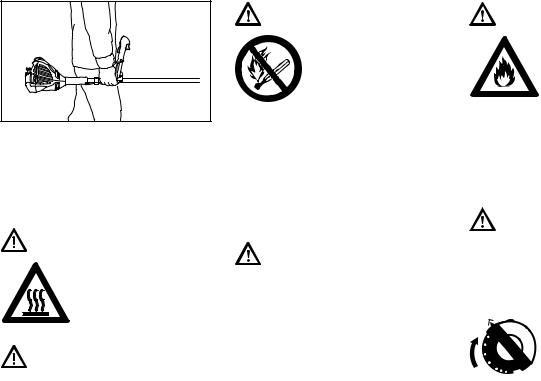
English
002BA272 KN
It may be carried only in a horizontal position. Grip the shaft in a manner that the machine is balanced horizontally. Keep the hot muffler away from your body and the cutting attachment behind you.
Warning!
To reduce the risk of burn injury, do not touch hot parts of the machine and the gear housing when they are hot.
Warning!
Always shut off the engine and make sure the cutting attachment has stopped before putting a clearing saw down. When transporting it in a vehicle, properly secure it to prevent turnover, fuel spillage and damage to the unit. STIHL recommends that you keep metal blades covered with the transport guard (optional accessory).
Fuel
Your STIHL power tool uses an oilgasoline mixture for fuel (see the chapter on "Fuel" of your instruction manual).
Warning!
Gasoline is an extremely flammable fuel. If spilled and ignited by a spark or
other ignition source, it can cause fire and serious burn injury or
property damage. Use extreme caution when handling gasoline or fuel mix. Do not smoke or bring any fire or flame near the fuel or the power tool. Note that combustible fuel vapor may escape from the fuel system.
Fueling Instructions
Warning!
Fuel your power tool in well-ventilated areas, outdoors. Always shut off the engine and allow it to cool before refueling. Gasoline vapor pressure may build up inside the fuel tank depending on the fuel used, the weather conditions and the tank venting system.
In order to reduce the risk of burns and other personal injury from escaping gas vapor, remove the fuel filler cap on your power tool carefully so as to allow any pressure build-up in the tank to release slowly. Never remove the fuel filler cap while the engine is running.
Select bare ground for fueling and move at least 10 feet (3 m) from the fueling spot before starting the engine. Wipe off any spilled fuel before starting your machine.
Warning!
Check for fuel leakage while refueling and dur-
ing operation. If fuel leakage is found, do not start or run the engine until the leak is fixed and
any spilled fuel has been wiped away. Take care not to get fuel on your clothing. If this happens, change your clothing immediately.
Cap with Grip
Warning!
In order to reduce the risk of fuel spillage and fire from an improperly tightened fuel cap, correctly position and tighten the fuel cap in the fuel tank opening.
To do this with this STIHL
cap, raise the grip on the
top of the cap until it is
upright at a 90° angle. Insert the cap in the fuel tank opening with the triangular marks on the grip of the cap and on the fuel tank opening lining up. Using the grip, turn the cap firmly clockwise as far as it will go (approx. a quarter turn).
6 |
FS 260 C, FS 360 C |
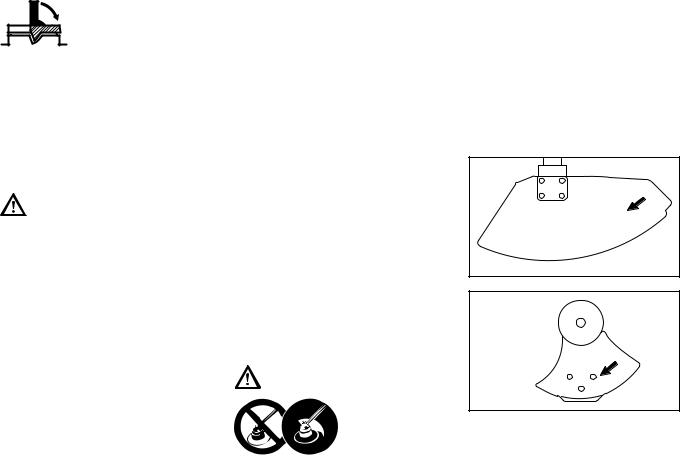
Fold the grip flush with the top of the cap. If the grip does not lie completely flush with the cap and the detent on the grip does not fit in the corresponding recess in the filler opening, the cap is not properly seated and tightened and you must repeat the above steps.
Before Starting
Warning!
Always check your power tool for proper condition and operation before starting, particularly the throttle trigger, throttle trigger lockout, momentary stop switch, cutting attachment, deflector and harness. The throttle trigger must move freely and always spring back to the idle position. Never attempt to modify the controls or safety devices.
 Warning!
Warning!
Never operate your power tool if it is damaged, improperly adjusted or maintained, or not completely or securely assembled.
 Warning!
Warning!
Do not attach any cutting attachment to a unit without proper installation of all required parts. Failure to use the proper parts may cause the blade or head to fly off and seriously injure the operator or bystanders.
 Warning!
Warning!
The cutting attachment must be properly tightened and in safe operating condition. Inspect for loose parts (nuts, screws, etc.) and for cracked or damaged heads or cracked, bent, warped or damaged blades. Replace damaged heads or blades before using the power tool. Always keep blades sharp.
Keep the handles clean and dry at all times; it is particularly important to keep them free of moisture, pitch, oil, fuel mix, grease or resin in order for you to maintain a firm grip and properly control your power tool.
 Warning!
Warning!
Check that the spark plug boot is securely mounted on the spark plug – a loose boot may cause arcing that could ignite combustible fumes and cause a fire.
Warning!
To reduce the risk of personal injury
to the operator from blade or line contact and
thrown objects, make sure your unit is equipped with the proper deflector, limit stop and harness for the type of cutting attachment being used (see chart in the chapter on "Approved Combinations of Cutting Attachment, Deflector, Limit Stop and Harness").
English
As can be seen in that chart, some cutting attachments may require you to change your deflector, limit stop and / or harness.
Keep the deflector (and the attached skirt where appropriate) adjusted properly at all times (see chapters on "Mounting the Deflector" and "Mounting the Cutting Attachment" of your instruction manual).
A
000BA006 KN
B
000BA007 KN
Arrows on the deflector (A) and limit stop (B) (as seen from the underside) show the correct direction of rotation of the cutting attachment. When viewed from above, however, the cutting attachment rotates counterclockwise.
Some of the following symbols may be embossed on the outside of the deflector in order to indicate the approved combination of cutting attachment and deflector.
FS 260 C, FS 360 C |
7 |
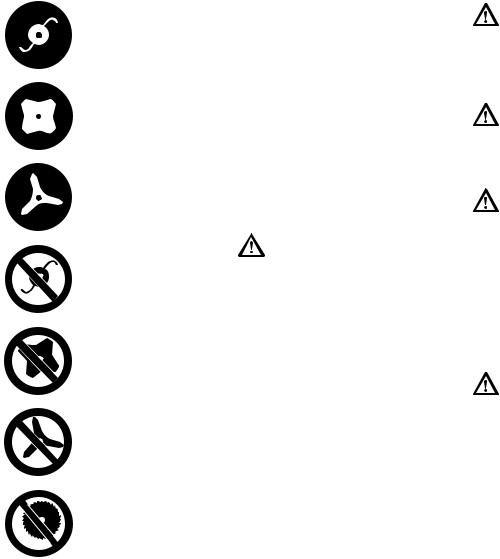
English
The deflector may be used in combination with mowing heads.
The deflector may be used in combination with grass cutting blades.
The deflector may be used in combination with brush knives.
The deflector must not be used in combination with mowing heads.
The deflector must not be used in combination with grass cutting blades.
The deflector must not be used in combination with brush knives.
The deflector must not be used in combination with circular saw blades.
Adjust carrying harness and hand grip to suit your size before starting work. The machine should be properly balanced as specified in your instruction manual for
8
proper control and less fatigue in operation. To be better prepared in case of an emergency, practice releasing the unit from the harness as quickly as possible.
Starting
Start the engine at least 10 feet (3 m) from the fueling spot, outdoors only.
For specific starting instructions, see the appropriate section of your manual. Place the power tool on firm ground or other solid surface in an open area. Maintain good balance and secure footing.
Warning!
To reduce the risk of injury from blade or line contact, be absolutely sure that the cutting attachment is clear of you and all other obstructions and objects, including the ground, because when the engine starts at starting-throttle, engine speed will be fast enough for the clutch to engage and move the cutting attachment.
Once the engine has started, immediately blip the throttle trigger, which should release the starting throttle and allow the engine to slow down to idle.
With the engine running only at idle, attach the power tool to the spring hook of your harness (see appropriate chapter of this manual).
Warning!
Your power tool is a one-person machine. Do not allow other persons in the general work area, even when starting.
Warning!
To reduce the risk of injury from loss of control, do not attempt to "drop start" your power tool.
Warning!
When you pull the starter grip, do not wrap the starter rope around your hand. Do not let the grip snap back, but guide the starter rope to rewind it properly. Failure to follow this procedure may result in injury to your hand or fingers and may damage the starter mechanism.
Important Adjustments
Warning!
To reduce the risk of personal injury from loss of control or contact with the running cutting attachment, do not use your unit with incorrect idle adjustment. At correct idle speed, the cutting attachment should not move. For directions on how to adjust idle speed, see the appropriate section of your instruction manual.
If you cannot set the correct idle speed, have your STIHL dealer check your power tool and make proper adjustments and repairs.
FS 260 C, FS 360 C
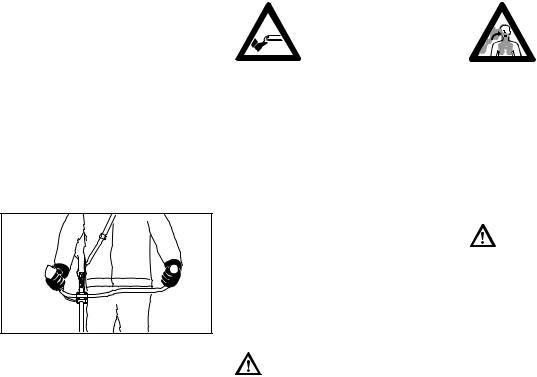
 Warning!
Warning!
This unit is equipped with an ignition system that is normally in operational readiness. After the setting lever is used to stop the engine, it automatically springs back to the "on" position. If the engine is warm, it may be possible to start it by simply pulling the starter rope, with no further adjustments. To reduce the risk of injury, be particularly alert to keep children away from the unit.
During Operation
Holding and Controlling the Power
Tool
002BA257 KN
Always hold the unit firmly with both hands on the handles while you are working. Wrap your fingers and thumbs around the handles, keeping the handles cradled between your thumb and forefinger.
 Warning!
Warning!
Never attempt to operate your power tool with one hand. Loss of control of
the power tool resulting in serious or fatal injury may result. To reduce the risk
of cut injuries, keep hands and feet away from the cutting attachment. Never touch a moving cutting attachment with your hand or any other part of your body.
 Warning!
Warning!
Do not overreach. Keep proper footing and balance at all times. Special care must be taken in slippery conditions (wet ground, snow) and in difficult, overgrown terrain. Watch for hidden obstacles such as tree stumps, roots and ditches to avoid stumbling. For better footing, clear away scrub and cuttings. Be extremely cautious when working on slopes or uneven ground.
Warning!
To reduce the risk of injury from loss of control, never work on a ladder or on any other insecure support. Never hold the cutting attachment above waist height.
Working Conditions
Operate and start your power tool only outdoors in a well-ventilated area. Operate it under good visibility and daylight conditions only. Work carefully.
English
 Warning!
Warning!
As soon as the engine is running, this product gen-
erates toxic exhaust fumes containing chemicals, such as unburned hydrocarbons (including
benzene) and carbon monoxide, that are known to cause respiratory problems, cancer, birth defects, or other reproductive harm. Some of the gases (e.g. carbon monoxide) may be colorless and odorless. To reduce the risk of serious or fatal injury / illness from inhaling toxic fumes, never run the machine indoors or in poorly ventilated locations.
Warning!
If the vegetation being cut or the surrounding ground is coated with a chemical substance (such as an active pesticide or herbicide), read and follow the instructions and warnings that accompanied the substance at issue.
FS 260 C, FS 360 C |
9 |
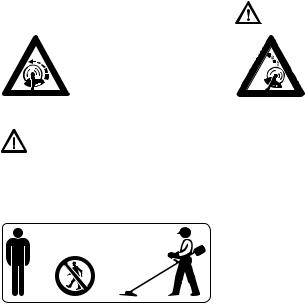
English
 Warning!
Warning!
Inhalation of certain dusts, especially organic dusts such as mold or pollen, can cause susceptible persons to have an allergic or asthmatic reaction. Substantial or repeated inhalation of dust and other airborne contaminants, in particular those with a smaller particle size, may cause respiratory or other illnesses. Control dust at the source where possible. Use good work practices, such as operating the unit so that the wind or operating process directs any dust raised by the power tool away from the operator. Follow the recommendations of EPA / OSHA / NIOSH and occupational and trade associations with respect to dust ("particulate matter"). When the inhalation of dust cannot be substantially controlled, i.e., kept at or near the ambient (background) level, the operator and any bystanders should wear a respirator approved by NIOSH / MSHA for the type of dust encountered.
Operating Instructions
 Warning!
Warning!
Do not operate your power tool using the starting throttle lock, as you do not have control of the engine speed.
In the event of an emergency, shut off the engine immediately – move the momentary stop switch to STOP.
 Warning!
Warning!
The cutting attachment continues to rotate for a short period after the throttle trigger is released (flywheel effect.
Warning!
The rotating cutting attachment may fling foreign objects directly or by ricochet a great distance.
 15m (50ft)
15m (50ft)
To reduce the risk of eye and other injury always wear proper eye protection (see the chapter on "Proper Clothing") and ensure that bystanders are at least
50 feet (15 m) away. To reduce the risk of damage to property, also maintain this distance from such objects as vehicles or windows. Any coworkers who must be in the restricted area should also wear goggles or protective glasses. Stop the engine immediately if you are approached.
Warning!
Before you start work, examine the area for stones, glass, fence
wire, metal, trash or
other solid objects. The cutting attachment could
throw objects of this kind.
 Warning!
Warning!
This clearing saw is normally to be used at ground level with the cutting attachment parallel to the ground. Use of a clearing saw above ground level or with the cutting attachment perpendicular to the ground may increase the risk of injury, since the cutting attachment is more fully exposed and the power tool may be more difficult to control. Never use your clearing saw as a hedge trimmer.
 Warning!
Warning!
During cutting, check the tightness and the condition of the cutting attachment at regular short intervals with the engine and attachment stopped. If the behavior of the attachment changes during use, stop the engine immediately, wait until the cutting attachment stops, and check the nut securing the attachment for tightness and the blade or head for cracks, wear and damage.
10 |
FS 260 C, FS 360 C |
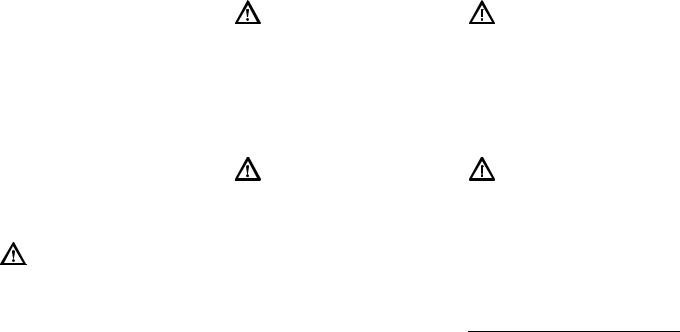
 Warning!
Warning!
A loose blade or head may vibrate, crack, break or come off the clearing saw, which may result in serious or fatal injury. Make sure that the cutting attachment is properly tightened. Use the wrench supplied or one of sufficient length to obtain the proper torque. If the blade or head loosens after being properly tightened, stop work immediately. The retaining nut may be worn or damaged and should be replaced. If the blade or head continues to loosen, see your STIHL dealer. Never use a clearing saw with a loose cutting attachment.
 Warning!
Warning!
Replace a cracked, damaged or wornout head or a cracked, bent, warped, damaged, dull or worn out blade immediately, even if damage is limited to superficial cracks. Such attachments may shatter at high speed and cause serious or fatal injury.
Warning!
When using rigid blades, avoid cutting close to fences, sides of buildings, tree trunks, stones or other such objects that could cause the power tool to kick out or could cause damage to the blade.
STIHL recommends use of the nylon line heads for such jobs. In addition, be alert to an increased possibility of ricochets in such situations.
 Warning!
Warning!
If the head, blade or deflector becomes clogged or stuck, always shut off the engine and make sure the cutting attachment has stopped before cleaning. Grass, weeds, etc. should be cleaned off the blade or from around the head at regular intervals.
Warning!
To reduce the risk of unintentional rotation of the cutting attachment and injury, always shut off the engine and remove the spark plug boot before replacing the cutting attachment. To reduce the risk of injury, always shut off the engine before adjusting the length of the nylon line on manually adjustable mowing heads.
Warning!
Do not turn the engine on over the starter with the spark plug boot or spark plug removed since there is otherwise a risk of fire from uncontained sparking.
 Warning!
Warning!
The gearbox becomes hot during operation. To reduce the risk of burn injury, do not touch the gear housing when it is hot.
English
 Warning!
Warning!
The muffler and other parts of the engine (e.g. fins of the cylinder, spark plug) become hot during operation and remain hot for a while after stopping the engine. To reduce risk of burns do not touch the muffler and other parts while they are hot.
Warning!
To reduce the risk of fire and burn injury, keep the area around the muffler clean. Remove excess lubricant and all debris such as pine needles, branches or leaves. Let the engine cool down sitting on concrete, metal, bare ground or solid wood away from any combustible substances.
Warning!
Never modify your muffler. The muffler could be damaged and cause an increase in heat radiation or sparks, thereby increasing the risk of fire and burn injury. You may also permanently damage the engine. Have your muffler serviced and repaired by your STIHL servicing dealer only.
USING THE CUTTING ATTACHMENT
For an illustration of the various cutting attachments and instructions on proper mounting see the chapter on "Mounting the Cutting Attachment" in your instruction manual.
FS 260 C, FS 360 C |
11 |
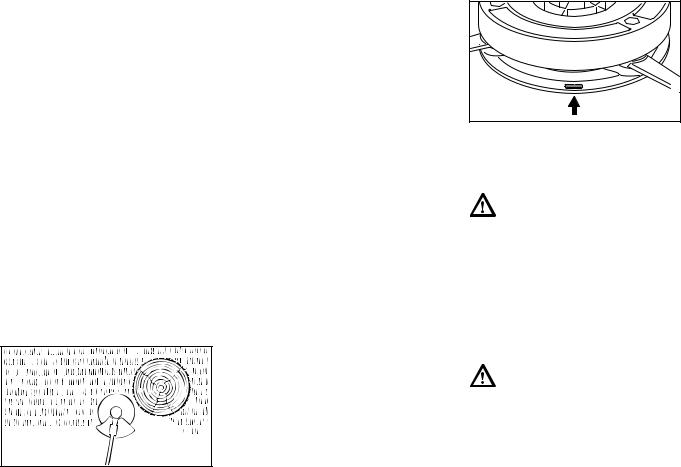
English
 Warning!
Warning!
To reduce the risk of severe or fatal injury from blade contact and / or loss of control, never attempt to use a metal blade on an FS model for which it is not authorized.
Using the Mowing Heads
Do not use with mowing line longer than the intended length. With a properly mounted deflector, the built-in linelimiting blade will automatically adjust the line to its proper length.
Using the unit with an overly long nylon cutting line increases the load on the engine and reduces its operating speed. This causes the clutch to slip continuously and results in overheating and damage to important components (e.g. clutch, polymer housing components). Such damage could, among other things, cause the cutting attachment to rotate at idle.




 002BA354 KN
002BA354 KN
Mowing heads are to be used only on clearing saws equipped with a linelimiting blade in the deflector in order to keep the line at the proper length (see "Main Parts" chapter in your instruction manual).
If the lawn edges are planted with trees or bordered by a fence etc., it is best to use a nylon line head. It achieves a "softer" cut with less risk of damaging tree bark etc. than polymer blades.
However, the polymer-bladed STIHL PolyCut produces a better cut if there are no plants along the edge of the lawn. Sharpening is not necessary, and worn polymer blades are easily replaced.
 Warning!
Warning!
To reduce the risk of serious injury, never use wire or metal-reinforced line or other material in place of the nylon cutting lines. Pieces of wire could break off and be thrown at high speed toward the operator or bystanders.
STIHL SuperCut mowing head
Fresh line is advanced automatically. Frayed line is replaced by a simple adjustment (see instruction sheet supplied with mowing head).
STIHL AutoCut mowing head
Nylon cutting line advances automatically when tapped against the ground (TapAction).
STIHL TrimCut mowing head
Frayed line is replaced by a simple adjustment (see instruction sheet supplied with mowing head).
STIHL PolyCut mowing head
002BA396 KN
Uses either nylon lines or nonrigid, pivoting polymer blades.
Observe wear indicators.
Warning!
Three rectangular wear limit marks are applied to the base (periphery) of the PolyCut. To reduce the risk of serious injury from breakage of the head or blades, the PolyCut must not be used when it has worn as far as one of these marks. It is important to follow the maintenance instructions supplied with the head.
Warning!
If the wear limit marks are ignored, there is a risk of the cutting attachment shattering and flying parts injuring the operator or bystanders. To reduce the risk of accidents from shattered blades, avoid contact with stones, metal and similar solid objects. Check PolyCut blades for cracks at regular intervals. If a crack is found on one blade, always replace all blades.
12 |
FS 260 C, FS 360 C |
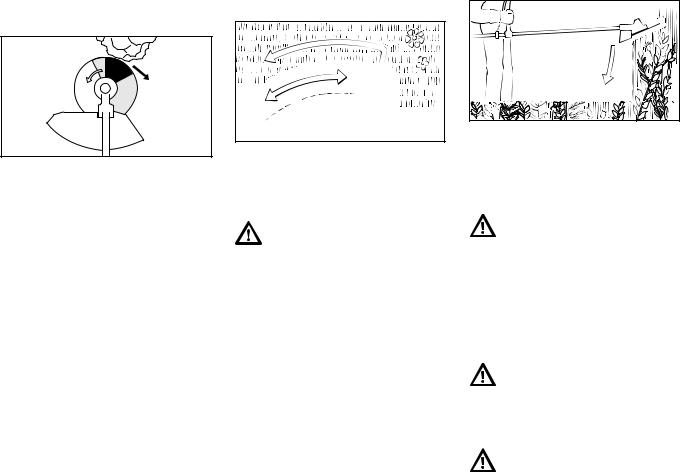
Risk of Kickout (Blade Thrust) with all |
Using the Grass Cutting Blade |
Rigid Cutting Blades |
|
002BA135 KN
 Warning!
Warning!
Kickout (blade thrust) is the sudden and uncontrolled motion towards the operator's right or rear that can occur when the shaded area (especially the darkly shaded area) of a rotating blade comes in contact with a solid rigid object like a tree, rock, bush or wall. The rapid counterclockwise rotation of the blade may be stopped or slowed, and the cutting attachment may be thrown to the right or to the rear.
This kickout (blade thrust) may cause loss of control of the power tool and may result in serious or fatal injury to the operator or bystanders. To reduce the risk of injury, extreme caution should be used when cutting with the shaded area of any rigid blade.









 002BA355 KN
002BA355 KN
All kinds of grass and weeds can be easily cut with the grass cutting blade. The power tool is swept in an arc similar to a scythe.
Warning!
To reduce the risk of serious or fatal injury from blade breakage, never attempt to use this blade to cut woody materials.
The 4-tooth grass cutting blade is intended to cut grass and weeds. It has 4 cutting knives with cutting edges on both sides, i.e. front and rear. When the cutting edges on one side become dull, the blade can be turned over to utilize the cutting edges on the other side.
The 8-tooth grass cutting blade is recommended for cutting fern or reed.
Both types of grass cutting blade have to be resharpened when all cutting edges are dull.
Using the Brush Knife
When fitted to the power tool, the brush knife is suitable for applications ranging from cutting matted grass to clearing weeds, wild growth and scrub.
English |
002BA066 KN |
To cut wild growth and scrub, lower the rotating brush knife down onto the growth to achieve a chopping effect – but keep the tool below waist height at all times.
Warning!
Exercise extreme caution when using this method of cutting. The higher the cutting attachment is off the ground, the greater the risk of loss of control and of cuttings being thrown sideways.
Use the power tool like a scythe to cut grass, i.e. sweep it to and fro in an arc.
Warning!
When cutting woody materials, use the left side of the blade to avoid "kickout" (blade thrust) situations.
Warning!
Improper use of a brush knife may cause it to crack, chip or shatter. Thrown blade fragments may seriously or fatally injure the operator or bystanders. To reduce the risk of injury, avoid contact with hard or solid foreign objects such as stones, rocks or pieces of metal.
FS 260 C, FS 360 C |
13 |
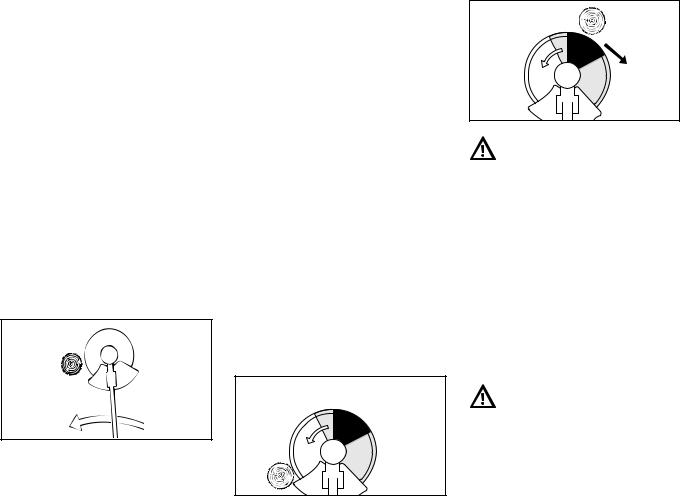
English
 Warning!
Warning!
When cutting young saplings or other woody materials up to 2 cm (3/4 in.) in diameter, use the left side of the blade to avoid "kickout" situations (see section on "Risk of kickout (blade thrust) with all rigid cutting blades"). Do not attempt to cut woody material with a larger diameter, since the blade may catch or jerk the power tool forward. This may cause damage to the blade or power tool or loss of control of the power tool, resulting in personal injury. Use a circular saw blade for such work.
 Warning!
Warning!
Inspect the brush knife at regular short intervals for signs of damage. Do not continue working with a damaged brush knife. Resharpen the brush knife regularly (when it has dulled noticeably).
Using the Circular Saw Blade
002BA067 KN
Circular saw blades are suitable for thinning brush and cutting small trees up to a diameter of 7 cm (2 3/4 in.). Do not attempt to cut trees with larger diameters, since the blade may catch or jerk the trimmer / brushcutter forward. This may cause damage to the blade or
loss of control of the power tool and result in serious injury. Use a chain saw for such work.
 Warning!
Warning!
To reduce the risk that the blade will crack and / or break, avoid all contact with stones, rocks or the ground. Sharpen blades in a timely manner as specified – dull teeth may cause the blade to crack or shatter.
When a clearing saw with a circular saw blade is used to cut down small trees, STIHL recommends that the standard deflector be removed and replaced by the special limit stop deflector (see chapter on "Mounting the Deflector"). This limit stop helps to keep the unit positioned against the tree during the cutting process. Inexperienced users should place the left side of the stop against the tree trunk before beginning to cut. This will keep the clearing saw against the tree during the cutting operation and will reduce the risk of loss of control and possible kickout (described above and briefly again below).
002BA214 ST
Before starting the cut, accelerate the engine up to full throttle. Perform cut with uniform pressure. STIHL recommends that the circular saw blade
be applied to the right of the tree, using the non-shaded area of the blade, as shown in the illustration above.
002BA068 KN
Warning!
The risk of kickout is highest when cutting in the darker shaded area. To reduce the risk of kickout and resulting injury, do not use this area of the circular saw blade for cutting trees or shrubs. Special techniques using the lighter shaded areas of the blade to cut shrubs and trees should only be used by experienced operators with specialized training in the use and control of the clearing saw.
When felling small trees, maintain a distance of at least two tree lengths from the nearest coworker.
Warning!
In order to reduce the risk of injury from thrown objects or operator contact with the blade or head, be sure to remount the standard deflector when no longer using a circular saw blade.
14 |
FS 260 C, FS 360 C |
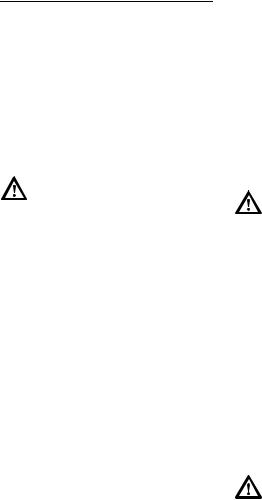
MAINTENANCE, REPAIR AND STORING
Maintenance, replacement, or repair of the emission control devices and systems may be performed by any nonroad engine repair establishment or individual. However, if you make a warranty claim for a component which has not been serviced or maintained properly or if nonapproved replacement parts were used, STIHL may deny coverage.
Warning!
Use only identical STIHL replacement parts for maintenance and repair. Use of non-STIHL parts may cause serious or fatal injury.
Strictly follow the maintenance and repair instructions in the appropriate sections of your instruction manual.
 Warning!
Warning!
Always stop the engine and make sure that the cutting attachment is stopped before doing any maintenance or repair work or cleaning the power tool. Do not attempt any maintenance or repair work not described in your instruction manual. Have such work performed by your STIHL servicing dealer only.
Wear gloves when handling or performing maintenance on blades.
 Warning!
Warning!
Use the specified spark plug, and make sure it and the ignition lead are always clean and in good condition. Always press the spark plug boot snugly onto the spark plug terminal of the proper size. (Note: If the terminal has a detachable SAE adapter nut, it must be securely attached.) A loose connection between the spark plug and the ignition wire connector in the boot may create arcing that could ignite combustible fumes and cause a fire.
Warning!
Never test the ignition system with the spark plug boot removed from the spark plug or with a removed spark plug, since uncontained sparking may cause a fire.
 Warning!
Warning!
Do not operate your power tool if the muffler is damaged, missing or modified. An improperly maintained muffler will increase the risk of fire and hearing loss. If your muffler was equipped with a spark-arresting screen to reduce the risk of fire, never operate your power tool if the screen is missing or damaged. Remember that the risk of forest fires is greater in hot or dry weather.
Warning!
Never repair damaged cutting attachments by welding, straightening or modifying the shape. This may cause parts of the cutting attachment to come off and result in serious or fatal injuries.
English
Keep blades sharp. Tighten all nuts, bolts and screws, except the carburetor adjustment screws, after each use.
Do not clean your machine with a pressure washer. The solid jet of water may damage parts of the machine.
Store the power tool in a dry and high or locked location out of reach of children.
Before storing for longer than a few days, always empty the fuel tank. See chapter "Storing the Machine" in the instruction manual.
FS 260 C, FS 360 C |
15 |
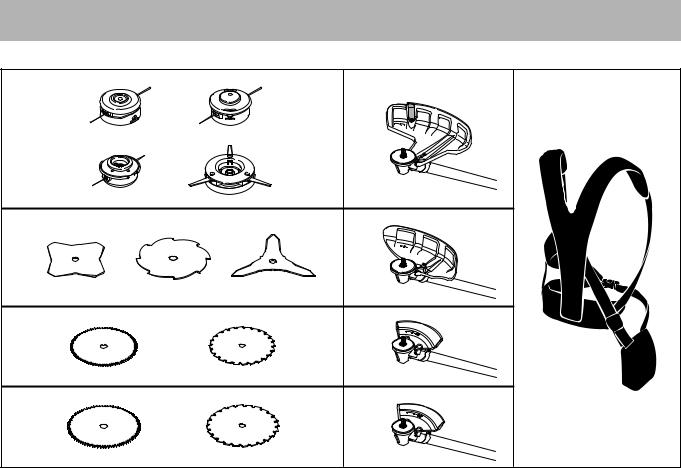
English
Approved Combinations of Cutting Attachment, Deflector, Limit Stop and Harness
Cutting attachment |
|
|
Deflector, limit stop |
Harness |
1 |
|
2 |
12 |
|
|
|
|
|
|
3 |
|
4 |
|
|
|
|
|
13 |
|
5 |
6 |
|
7 |
|
8 |
|
9 |
14 |
16 |
|
|
|||
10 |
|
11 |
15 |
KN |
|
|
|||
|
|
|
|
681BA171 |
16 |
FS 260 C, FS 360 C |

Permissible combinations
Choose the proper combination from the table depending on the cutting attachment!
For safety reasons only the cutting attachments and deflectors and/or limit stops within one line of the table may be combined with one another. Other combinations are not permissible – risk of accident!
Cutting attachments
Mowing heads
1STIHL SuperCut 40-2
2STIHL AutoCut 40-2
3STIHL TrimCut 41-2
4STIHL PolyCut 41-3
Metal cutting attachments
5Grass cutting blade 230-4
6Grass cutting blade 255-8
7Brush knife 300-3
8Circular saw blade 200 scratcher tooth
9Circular saw blade 200 chisel tooth
10Circular saw blade 225 scratcher tooth
11Circular saw blade 225 chisel tooth
Circular saw blades of other, nonmetal materials must not be used.
Deflectors, limit stops
Deflectors
12 Deflector only for mowing heads
FS 260 C, FS 360 C
13Deflector for the mowing tools Items 5 to 7
Limit stops
14Limit stop for circular saw blades 200
15Limit stop for circular saw blades 225
Harnesses
16 Full harness must be used
 Warning!
Warning!
Based on the cutting attachment being used:
Choose the proper deflector in order to reduce the risk of injury from thrown objects and contact with the cutting attachment.
Make sure your unit is equipped with the proper handle and harness in order to reduce the risk of injury from loss of control and contact with the cutting attachment.
Use grass cutting metal blades, brush knifes and circular saw blades on this unit only if equipped with a bike handle.
Do not use rigid polymer blades on this unit.
English
Mounting the Bike Handle
Mounting the bike handle with swiveling handle support
2
1 |
KN |
|
6BA018 |
The machine is supplied with the clamp moldings (1) mounted to the handlebar (2).
Mounting the control handle
|
3 |
|
5 |
|
KN |
|
002BA352 |
|
|
4 |
|
|
|
NTake out the screw (3) and remove the nut (4) from the control
handle (5).
17
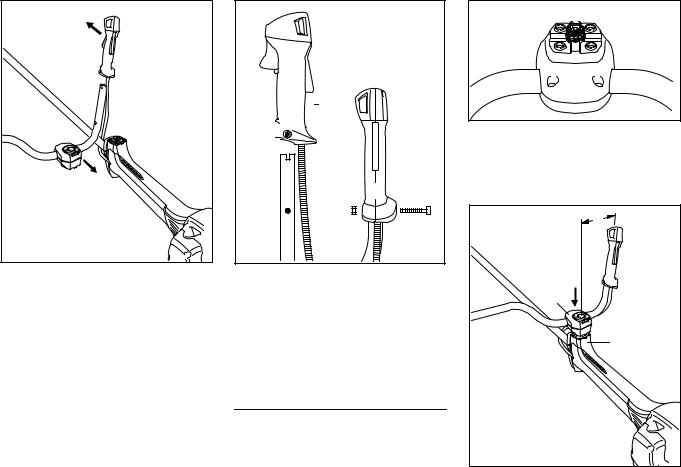
English |
5 |
6 |
2 |
7 |
6BA002 KN |
NLine up the control handle (5) relative to the handlebar (2): The throttle trigger (6) must point toward the gearbox and the clamp
screw (7) toward the engine.
 8
8 

2 |
5 |
|
4 |
3 |
|
8 |
|
|
6BA019 KN
NHolding the control handle (5) in that position, push it on to the end of the handlebar (2) and line up the holes (8).
NFit the nut (4) in the control
handle (5), insert the screw (3) and tighten it down firmly.
Assembling the handle support
Assembly of the swivelling handle support involves equipping the clamp moldings with a spring and mounting them on the handle support.
9
10
6BA001 KN
NUse the spring (9) from the parts kit supplied with the machine.
NPlace the spring (9) in the lower clamp molding (10).
A |
1 |
2 |
11 |
6BA020 KN |
NPosition the clamp moldings (1) with handlebar (2) on the handle support (11).
18 |
FS 260 C, FS 360 C |
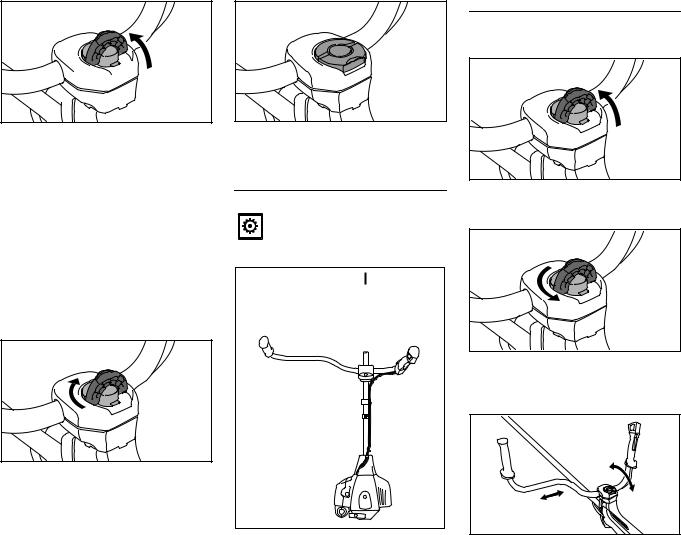
7
2 



 KN6BA003
KN6BA003
NRaise the grip of the wing screw (7) to the upright position.
NTurn the wing screw counterclockwise as far as stop.
NPush the wing screw into the handle support as far as stop and then screw it down – but do not finally tighten yet.
NAdjust the handlebar (2) so that distance A is no more than 15 cm.
NLine up the handlebar at a right angle to the drive tube.
6BA005 KN
NTurn the wing screw clockwise as far as stop.
6BA006 KN
NFold the grip of the wing screw down so that it is flush.
FS 260 C: Fitting the throttle cable
Do not kink the throttle cable or lay it in tight radii – make sure the throttle trigger moves freely.
 12
12  13
13
13 
12
002BA439 KN
NAttach the throttle cable (12) to the retainer (13).
English
Adjusting the handlebar
Opening the wing screw
6BA023 KN
NRaise the grip of the wing screw to the upright position.
6BA004 KN
NTurn the wing screw counterclockwise until the handle support can be moved.
6BA007 KN
NMove the handlebar to the required position.
FS 260 C, FS 360 C |
19 |
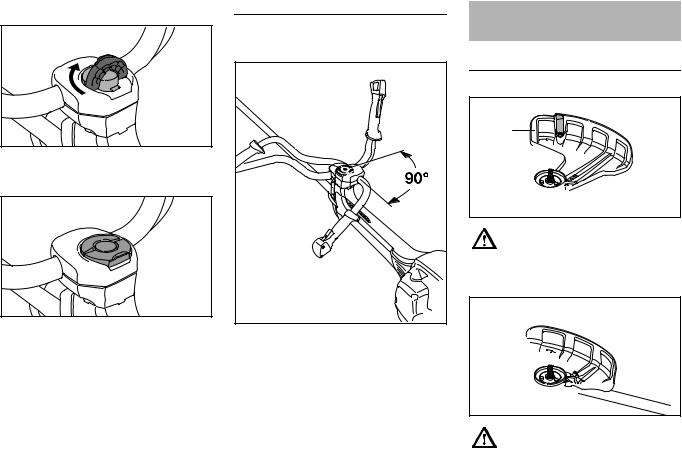
English
Closing the wing screw
6BA005 KN
NTurn the wing screw clockwise as far as stop.
6BA006 KN
NFold the grip of the wing screw down so that it is flush.
Swiveling the handlebar
Transport position
2 |
7 |
6BA008 KN |
NLoosen the wing screw (7) and unscrew it until the handlebar (2) can be turned clockwise.
NTurn the handlebar 90° and then swing the handles down.
NTighten down the wing screw (7) firmly.
Working position
NReverse the sequence described above to swing the handles up and turn the handlebar counterclockwise.
Mounting the Deflector
Using the proper deflector
1
 002BA401 KN
002BA401 KN
Deflector (1) is approved only for mowing heads, thus deflector (1) must be attached before attaching a mowing head.
2



 KN002BA402
KN002BA402
Deflector (2) is approved only for grass cutting blades, thus deflector (2) must be attached before attaching a grass cutting blade.
20 |
FS 260 C, FS 360 C |
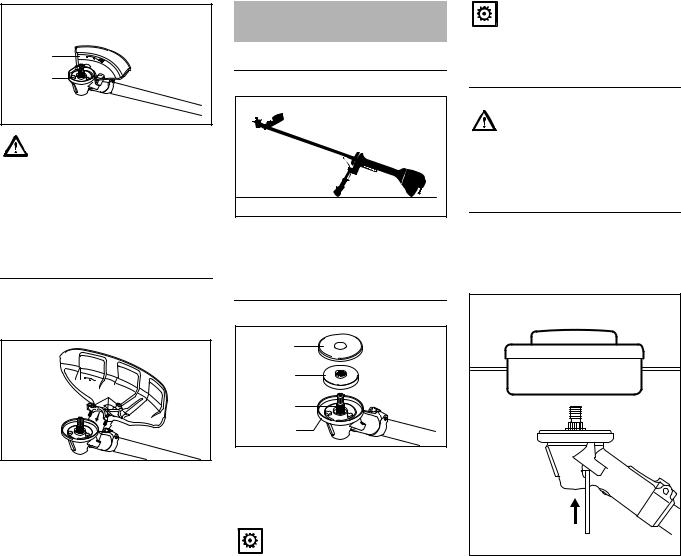
3
4 |
KN |
|
002BA433 |
Limit stop (3) is approved only for circular saw blades, thus limit stop (3) must be attached and guard ring (4) replaced before attaching a circular saw blade, see "Mounting the cutting attachment" / "Mounting circular saw blades".
Mounting the deflector
Deflectors (1-3) are attached to the gearbox in the same manner.
6
5 |
KN |
|
002BA434 |
||
|
N Set the deflector on the gearbox (5), N screw in and tighten the screws (6)
FS 260 C, FS 360 C
Mounting the Cutting
Attachment
Preparing the machine
002BA406 KN
NLay down the machine so that the mount for the cutting attachment faces upward
Attaching the thrust plate
2 |
|
1 |
|
3 |
KN |
4 |
002BA407 |
|
NPush the thrust plate (1) and guard washer (2) onto the shaft (3)
The machine is equipped at the factory with a guard ring (4) for mowing tools.
The thrust plate (1) on the gearbox is required for securing all cutting attachments.
English
The guard washer (2) on the gearbox is required for securing all cutting attachments with the exception of circular saw blades.
Mounting the cutting attachment
Use the appropriate deflector for the cutting attachment – see "Mounting the deflector".
Mounting the mowing heads STIHL SuperCut, STIHL AutoCut, STIHL TrimCut, STIHL PolyCut
N Use the guard ring for mowing tools
NAttach the deflector for mowing heads
1 |
002BA408 KN |
N Block the shaft
NTurn the mowing head counterclockwise onto the shaft (1) and tighten
21
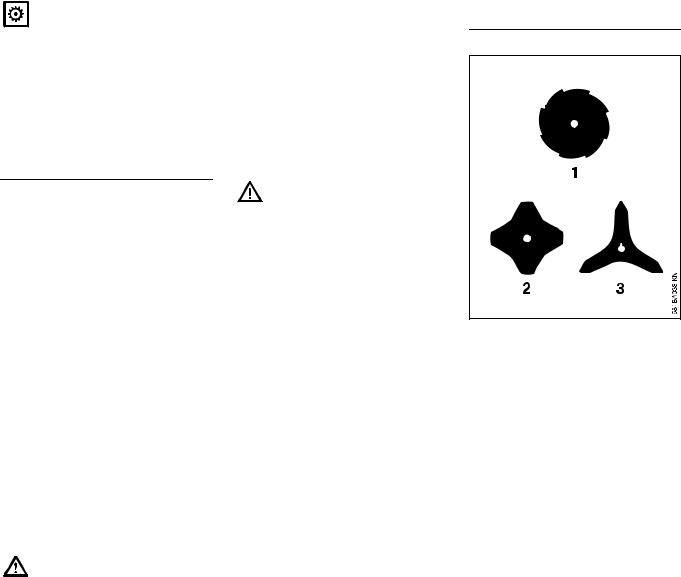
English
Remove the tool used to block the shaft.
Keep the information sheet for the mowing head in a safe place.
Removing the mowing head
N Block the shaft
NUnscrew the mowing head clockwise
Feeding out mowing line
A detailed description is contained in the information sheet for the respective mowing head.
SuperCut Mowing Head
Line is fed out automatically during mowing and shortened to optimum length by the blade on the deflector. Line is fed out only if both ends of the line are still at least 6 cm long.
AutoCut Mowing Head
NHold the machine over an area of lawn with the engine running (mowing head must rotate)
NTap the mowing head on the ground
– line is fed out automatically and shortened to optimum length by the blade on the deflector
Line is fed out only if both ends of the line are still at least 2.5 cm long.
TrimCut Mowing Head
Always switch off the engine to fed out mowing line by hand – otherwise there is a risk of injury!
NPull up the spool housing – turn counterclockwise – approx. 1/6 turn
– until it engages – and then allow it to spring back
N Pull the ends of the line outward
Repeat operation as needed until both ends of the line are approx. 13 cm long.
A rotary movement from one click to the next releases approx. 4 cm of line.
PolyCut Mowing Head
Always switch off the engine to load the mowing head by hand –
otherwise there is a risk of injury!
Proceed as described in the mowing head information sheet.
Attaching grass cutting blades, brush knives
With the grass cutting blade 255-8 (1), the cutting edges must face clockwise.
Cutting attachments with 3 or
4 blades (2, 3) can face in any direction
– turn over these cutting attachments periodically to avoid uneven wear.
N Use the guard ring for mowing tools
NAttach the deflector for metal mowing tools
22 |
FS 260 C, FS 360 C |
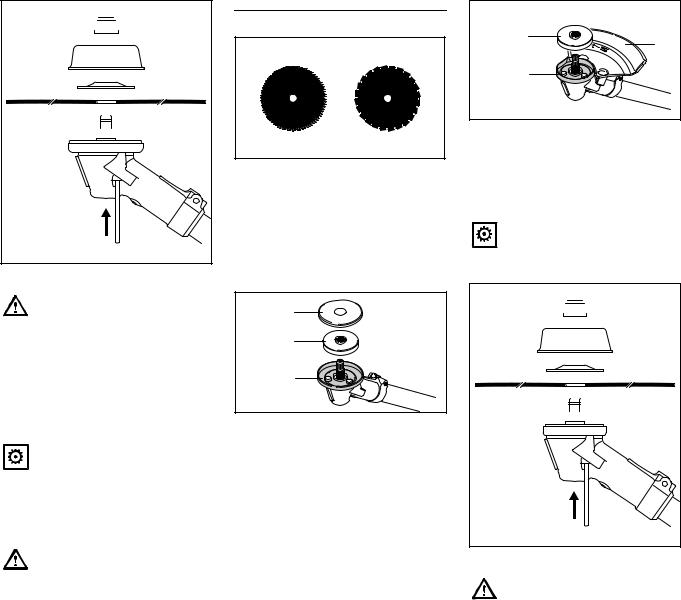
4
3
2 1
b 
 a
a 

002BA409 KN
N Position cutting attachment (1)
The collar (a) must engage the hole (b) in the cutting attachment!
NFit the thrust washer (2) – curvature faces upward
N Position thrust plate (3)
N Block the shaft
NScrew on the nut (4) counterclockwise and tighten
Remove the tool used to block the shaft.
Removing cutting attachments
N Block the shaft
N Unscrew the nut clockwise
A nut that moves too easily should be replaced.
Attaching circular saw blades
681BA165 KN
With circular saw blades, the cutting edges must face clockwise.
For attaching circular saw blades, a limit stop set is available as a special accessory that contains a limit stop and a guard ring for circular saw blades.
Change guard ring
|
English |
4 |
7 |
|
|
6 |
KN |
|
002BA425 |
NAttach guard ring (6) for circular saw blades
N Push thrust plate (4) onto the shaft
NAttach limit stop (7) for circular saw blades
Do not use the guard washer (3) for circular saw blades.
Mounting the cutting attachment
3
4
5 |
KN |
|
002BA424 |
||
|
NRemove guard washer (3) and thrust plate (4)
NRemove guard ring (5) for mowing tools
4
3
2 1
b 
 a
a 

002BA423 KN
N Position cutting attachment (1)
The collar (a) must engage the hole (b) in the cutting attachment!
FS 260 C, FS 360 C |
23 |
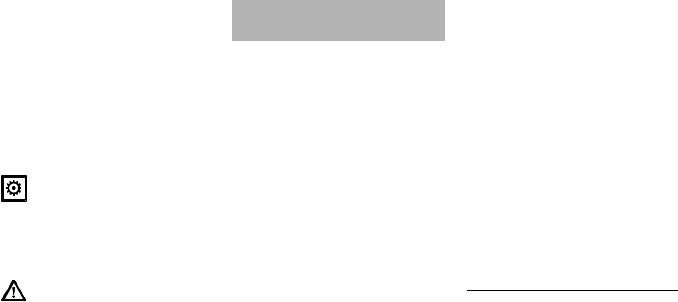
English
NFit the thrust washer (2) – curvature faces upward
N Position thrust plate (3)
A thrust plate (3) for sawing use, with which the entire cutting depth of the circular saw blade can be used, is available as a special accessory.
N Block the shaft
NScrew on the nut (4) counterclockwise and tighten
Remove the tool used to block the shaft.
Removing cutting attachments
N Block the shaft
N Unscrew the nut clockwise
A nut that moves too easily should be replaced.
Fuel
This engine is certified to operate on unleaded gasoline and the STIHL twostroke engine oil at a mix ratio of 50:1.
Your engine requires a mixture of highquality gasoline and quality two-stroke air cooled engine oil.
Use mid-grade unleaded gasoline with a minimum octane rating of 89 (R+M/2). If the octane rating of the mid-grade gasoline in your area is lower, use premium unleaded fuel.
Fuel with a lower octane rating may increase engine temperatures. This, in turn, increases the risk of piston seizure and damage to the engine.
The chemical composition of the fuel is also important. Some fuel additives not only detrimentally affect elastomers (carburetor diaphragms, oil seals, fuel lines, etc.), but magnesium castings and catalytic converters as well. This could cause running problems or even damage the engine. For this reason STIHL recommends that you use only nationally recognized high-quality unleaded gasoline!
Use only STIHL two-stroke engine oil or equivalent high-quality two-stroke engine oils that are designed for use only in air cooled two-cycle engines.
We recommend STIHL 50:1 two-stroke engine oil since it is specially formulated for use in STIHL engines.
Do not use BIA or TCW rated (twostroke water cooled) mix oils or other mix oils that state they are for use in both
water cooled and air cooled engines (e.g., outboard motors, snowmobiles, chain saws, mopeds, etc.).
Take care when handling gasoline. Avoid direct contact with the skin and avoid inhaling fuel vapor. When filling at the pump, first remove the canister from your vehicle and place the canister on the ground before filling. Do not fill fuel canisters that are sitting in or on a vehicle.
The canister should be kept tightly closed in order to avoid any moisture getting into the mixture.
The machine‘s fuel tank and the canister in which fuel mix is stored should be cleaned as necessary.
Fuel mix ages
Only mix sufficient fuel for a few days work, not to exceed 3 months of storage. Store in approved fuel-canisters only. When mixing, pour oil into the canister first, and then add gasoline. Close the canister and shake it vigorously by hand to ensure proper mixing of the oil with the fuel.
Gaso- |
Oil (STIHL 50:1 or equiva- |
line |
lent high-quality oils) |
US gal. |
US fl.oz |
1 |
2.6 |
2 1/2 |
6.4 |
5 |
12.8 |
Dispose of empty mixing-oil canisters only at authorized disposal locations.
24 |
FS 260 C, FS 360 C |
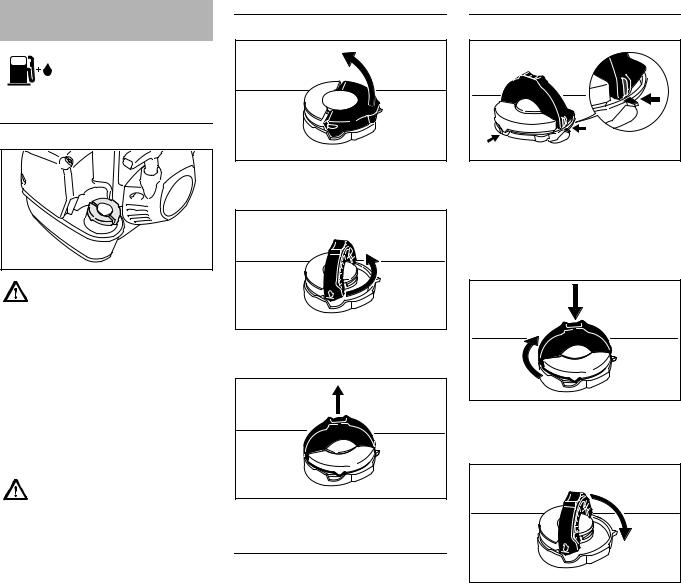
Fueling
Preparations
9926BA005 KN
When fueling on a slope, always position the machine so that the filler cap is facing uphill.
NOn level ground, position the machine so that the filler cap is facing up.
NBefore fueling, clean the filler cap and the area around it to ensure that no dirt falls into the tank.
Always thoroughly shake the mixture in the canister before fueling your machine.
In order to reduce the risk of burns or other personal injury from escaping gas vapor and fumes, remove the fuel filler cap carefully so as to allow any pressure buildup in the tank to release slowly.
Opening |
001BA218 KN |
NRaise the grip into an upright position.
001BA219 KN |
NTurn the cap counterclockwise (approx. 1/4 turn).
001BA224 KN |
N Remove fuel filler cap.
Refueling
Take care not to spill fuel while fueling and do not overfill the tank.
English
Closing
001BA220 KN
With grip in an upright position:
NInsert the cap – positioning marks on the cap and the fuel tank opening must line up.
NThe cap should drop fully into the opening in this position.
001BA221 KN |
NWhile pressing the cap down, twist it firmly clockwise as far as it will go (approx. 1/4 turn).
001BA222 KN |
N Fold down the grip.
FS 260 C, FS 360 C |
25 |

English
Checking for proper closure
001BA223 KN |
NThe lug on the grip must engage entirely in the recess (arrow), and the grip must lie completely flush with the top of the cap.
001BA225 KN
NGrip the cap and check for tightness.
NIf the cap can be moved, it is not properly installed.
Misalignment of the cap parts
NIf the cap does not drop fully into the opening when the positioning marks line up and/or if the cap does not tighten properly when twisted, the base of the cap may be rotated out of position vis-à-vis the top.
NSuch misalignment can result from handling, cleaning or an improper attempt at tightening.
001BA227 KN |
Left: |
Base of improperly aligned |
|
cap (with open space) |
Right: |
Base of cap correctly posi- |
|
tioned for installation |
001BA226 KN |
NTo correct a misalignment, turn the cap (with the grip up) until it drops fully into the tank opening.
NTwist the cap counterclockwise as far as it will go (approx. 1/4 turn) – this will twist the base of the cap into the correct position.
NTwist the cap clockwise, closing it normally – see the sections "Closing" and "Checking for proper closure."
NIf your cap still does not tighten properly, it may be damaged or broken; immediately stop use of the unit and take it to your authorized STIHL dealer for repair.
Fitting the Full Harness
Fitting the full harness is described in detail in the instruction sheet supplied.
FS 260 C |
1 |
2 |
002BA386 KN |
N Put on the full harness (1).
NAdjust the length of the strap so that the carabiner (2) is about a hand’s width below your right hip.
NBalance the machine – see "Balancing the Machine".
26 |
FS 260 C, FS 360 C |
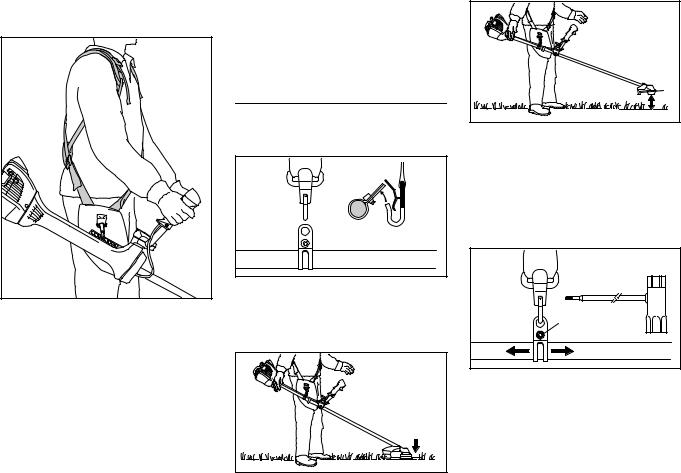
FS 360 C |
|
|
|
|
Balancing the |
||
|
|||
|
|
Trimmer/Brushcutter |
|
|
|
|
The type and version of the harness and
snap hook depend on the market.
1
FS 260 C
|
Connect machine to harness |
|
|
|
2 |
|
|
|
1 |
|
|
2 |
1 |
|
|
2 |
KN |
||
3 |
|||
|
002BA387 |
||
002BA411KN |
N Hook the snap hook (1) into the |
||
N Put on the full harness (1). |
carrying ring (2) on the drive tube |
|
|
|
|
||
N Adjust the length of the strap so that |
Hanging positions |
|
|
the carabiner (2) is about a hand’s |
|
|
|
width below your right hip. |
|
|
N Attach the spring hook to the machine's perforated strip (3).
Find the right attachment point for the |
|
cutting attachment you are using – see |
KN |
"Balancing the Machine". |
002BA388 |
|
Mowing heads, grass cutting blades and brush knives should rest lightly on the ground.
English |
002BA389 KN |
Circular saw blades should "hover" approx. 8 in. (20 cm) above the ground.
Carry out the following steps to attain the proper hanging position:
Letting the machine swing until it stops moving
2 |
3 |
KN |
|
002BA390 |
|
|
|
N Undo the screw (3)
NAdjust carrying ring (2) – tighten screw lightly – let the machine swing until it stops moving – check hanging position
Once the proper hanging position has been attained:
NTighten the screw on the carrying ring
FS 260 C, FS 360 C |
27 |
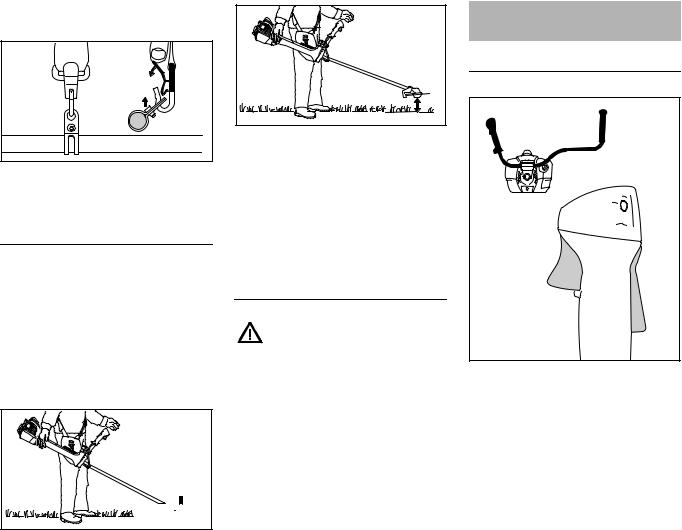
English
Disconnecting the machine from the harness
1 |
|
1 |
2 |
2 |
KN |
|
|
002BA391 |
NPress the spring on the snap hook (1) and remove the carrying ring (2) from the hook
FS 360 C
The machine will balance differently depending on the cutting attachment mounted.
NLet the machine swing on the harness until it stops moving – change the connection point if necessary
Hanging positions
 6BA009 KN
6BA009 KN
Mowing heads, grass cutting blades and brush knives should rest lightly on the ground.
6BA010 KN |
Circular saw blades should "hover" approx. 8 in. (20 cm) above the ground.
Disconnecting the machine from the harness
NPress the spring on the snap hook and remove the perforated strip from the hook
Putting down the machine in an emergency
As soon as it becomes apparent that a dangerous situation is developing, the machine must be put down quickly. To put down the machine, proceed as in "Disconnecting the machine from the harness". Practice setting down the machine quickly. In order to avoid damage, when practicing, do not throw the machine on the ground.
Starting / Stopping the
Engine
Controls
3
2
1
002BA392 KN
1Throttle trigger lockout
2Throttle trigger
3Stop switch with Run and Stop positions. Push the stop switch (STOP) to switch off the ignition.
Function of stop switch and ignition system
The stop switch is normally in the Run position: Ignition is on in this position – the engine is ready to start and may be started. The ignition is switched off when the stop switch is depressed. It is automatically switched on again after the engine comes to a standstill.
28 |
FS 260 C, FS 360 C |
